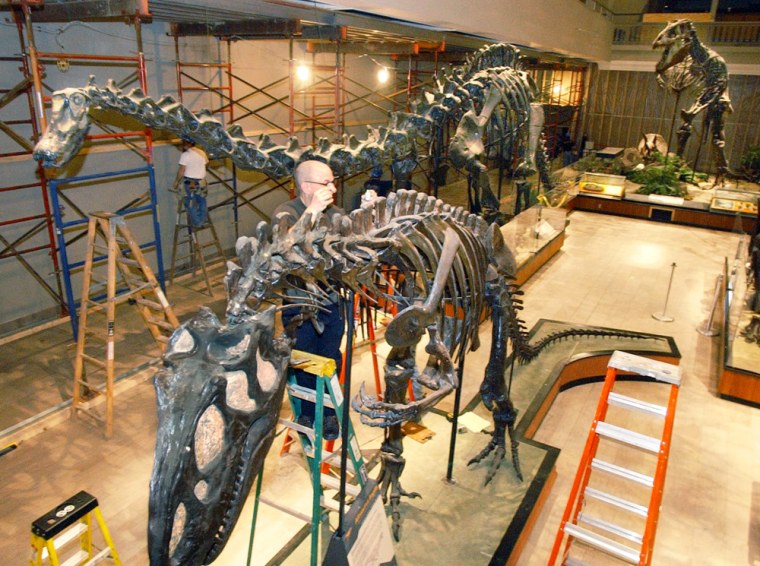What could be better than seeing the first tyrannosaurus rex ever discovered? Watching it being taken apart. Visitors to the Carnegie Museum of Natural History, which has one of the oldest and largest dinosaur collections in the nation, will be able to watch as the museum's collection of fossilized dinosaur skeletons are taken apart before a renovation of the museum's almost century-old Dinosaur Hall.
"People can come in and watch the disarticulation process and watch as they are being reconstructed. We are combining the two things kids of any age love: construction and dinosaurs," said Bill DeWalt, director of the museum.
The first dinosaur to come down will be the allosaurus. A large two-legged predator like the T. rex, the allosaurus will be decapitated Monday. Four other dinosaurs will also be taken down and more may be assembled over the next two years as part of the renovation.
The $35 million renovation will triple the size of the museum's Dinosaur Hall, which started with one skeleton — the sauropod Diplodocus carnegii (named for steel magnate Andrew Carnegie). After it's done, the museum will have room to show off more of its dinosaurs in more dramatic and scientifically accurate poses.
The dinosaurs are now in turn-of-the-century poses with their tails dragging on the ground; the tyrannosaurus stands like a kangaroo or Godzilla.
The Pittsburgh museum is among the last major natural history museums to update its dinosaur collection to reflect current scientific thought.
"Dinosaurs were always viewed as bulky, hulking looking animals, so nobody was moving fast. If you look at the 1920s, they are old and slow and big, hulking reptiles," said Judd Case, a paleontologist and dean at St. Mary's College of California.
Early paleontologists weren't concerned as much with figuring out what dinosaurs looked like so much as where they could find the next one.
"It was like finding a new stamp to add to the collection. People were not looking at them in terms of taxonomy," Case said.
In the 1970s, paleontologists and paleobiologists began to challenge widely held views of how dinosaurs carried themselves and starting taking harder looks at what the bones could tell them. Now, scientists believe few dinosaurs dragged their tails on the ground; most likely held them aloft and used them for balance.
There have been other changes too.
In movies and some museums, for example, sauropods often are shown using their long necks to grab leaves from trees like giraffes. Recent computer models showed the bones in their 40-foot-necks weren't built for moving their tiny heads much above their shoulders. So, they more likely were grazers.
The Carnegie Museum of Natural History is the third-largest repository of dinosaur fossils in the world, after the American Museum of Natural History in New York City and the Smithsonian Institution. Discovery.com named it the sixth best place in the world to see dinosaurs, and Forbes.com calls it home to one of the best dinosaur collections in the United States.
The Dinosaur Hall now is home to 15 skeletons of dinosaurs, including some by which all other skeletons are judged — the diplodocus (found in 1899 and now the museum's mascot, nicknamed "Dippy"), the Apatosaurus louisae (formerly known as the Brontosaurus and named for Carnegie's wife when it was found in 1909) and the T. rex (the first one found in 1902 and bought from the American Museum of Natural History in 1941).
Casts of the diplodocus skeleton were sent to 12 museums worldwide, including the British Museum.
DeWalt, the Carnegie Museum director, said the museum had long wanted to remount the Carnegie's dinosaurs to reflect the new science but didn't have the space.
"The good thing about having the tails down is you have more floor space. ... If you are going to remount them you want them in a better space instead of just having them crammed in like marching soldiers," DeWalt said.
